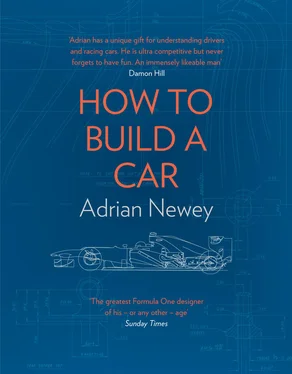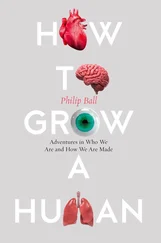‘Why, Newey?’
‘Well, if we didn’t have friction, none of us would be able to stand up. We’d all slip over.’
The teacher did a double-take as though suspecting mischief. But despite the titters of my classmates, I was deadly serious. He rolled his eyes. ‘That’s ridiculous,’ he sighed, ‘friction is clearly a bad thing. Why else would we need oil?’
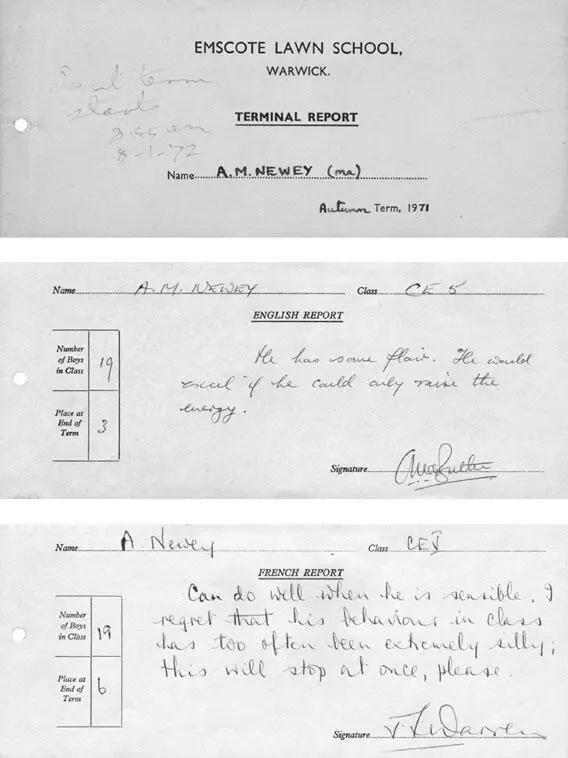
A selection of school reports.
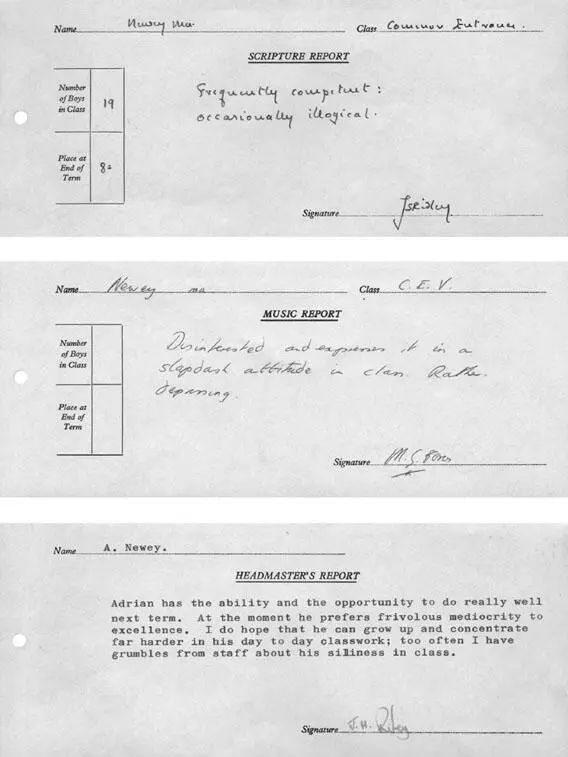
Right then I knew I had a different way of looking at the world. Thinking about it now, I’m aware that I’m also possessed of an enormous drive to succeed, and maybe that comes from wanting to prove I’m not always wrong, that friction can be a good thing.
Dad loved cars but he wasn’t especially interested in motorsport. Meanwhile my passion in that area had only intensified through my early years. As a young lad I persuaded him to take me to a few races.
One such meet was the Gold Cup at Oulton Park in Cheshire in 1972, and it was there, thanks to some judicious twisting of my dad’s arm, that we’d taken the (second) yellow Elan CGWD 714K one early summer morning: my very first motor race.
At the circuit we wandered around the paddock – something you could often do in those days – and I was almost overwhelmed by the sights but mainly the sounds of the racetrack. It was like nothing I’d ever heard before. These huge, full-throated, dramatic-sounding V8 DFV engines, the high-pitched BRM V12 engines; the mechanics tinkering with them, fixing what, I didn’t know, but I was fascinated to watch anyway, inconceivably pleased if I was able to identify something they were doing. ‘Dad, they’re disconnecting the rear anti-roll bar!’
I’d seen real racing cars before. In another act of supreme arm-twisting, I’d persuaded my dad to take me to the Racing Car Show at Olympia in London. But Oulton Park was the first time I’d seen them in the wild, in their natural habitat and, what’s more, actually moving . It’s an undulating track and the cars were softly sprung in those days. I found myself transfixed by watching the ride-heights change as cars thundered over the rise by the start/finish line. I was already in love with motor racing but I fell even harder for it that day.
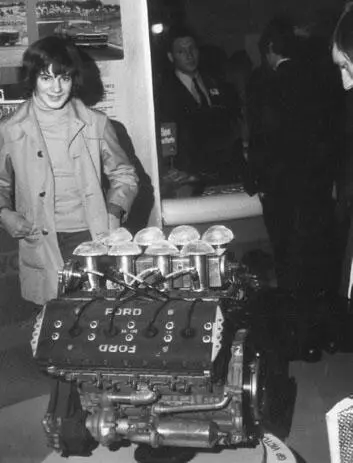
Posing with the Cosworth DFV engine at the Racing Car Show.
My second race was at Silverstone for the 1973 Grand Prix, where Jackie Stewart was on pole, and the young me was allowed a hamburger. Stewart on pole was par for the course in those days, but the hamburger was something of a rarity, as another of my father’s many foibles was his absolute hatred of junk food. He was always very Year Zero about things like that. When the medical profession announced that salt was good for you, he would drink brine in order to maintain his salt levels on a hot summer day. When the medical profession had a change of heart and decided that salt was bad for you after all, he cut it out altogether, wouldn’t even have it in the water for boiling peas.
That afternoon, for whatever reason, perhaps to make up for the fact that we didn’t wander around the paddock as we had done at the Gold Cup, Dad relaxed his no-junk-food rule and bought me a burger from a stall at the bottom of the grandstand at Woodcote, which in those days was a very fast corner at the end of the lap, just before the start/finish line.
We took our seats for the beginning of the race, and I sat enthralled as Jackie Stewart quickly established what must have been a 100-yard lead on the rest of the pack as he came round at the end of the first lap.
Then, before I knew it, two things happened. One: the young South African Jody Scheckter, who had just started driving for the McLaren team, lost control of his car in the quick Woodcote corner, causing a huge pile-up. It was one of the biggest crashes there had ever been in Formula One, and it happened right before my very eyes.
And two: I dropped my burger from the shock of it.
My memory is of the whole grandstand rising to its feet as the accident unfolded, of cars going off in all directions, and an airbox hurtling high in the air, followed by dust and smoke partly obscuring the circuit. It was very exciting but also shocking; was somebody hurt or worse? It seemed inconceivable they wouldn’t be. I recall the relief of watching drivers clamber unhurt from the wreckage (the worst injury was a broken leg). Once the excitement subsided it became obvious we’d now have to wait an age for marshals to clear the track. There was only one thing for it, I clambered underneath the bottom of the grandstand, retrieved my burger and carried on eating it.
At 13 I was packed off to Repton School in Derbyshire. My grandfather, father and brother had all attended Repton, so it wasn’t a matter for debate whether I went or not. Off I went, a boarder for the first time, beginning what was set to be another academically undistinguished period of my life.
Except this time it was worse, because the immediate and rather dismaying difference between Emscote Lawn and Repton was that at Emscote Lawn I was popular with other pupils, which meant that even though I wasn’t doing well in lessons, at least I was having a decent time. But at Repton, I was much more of an outcast.
The school was and maybe still is very sports orientated, but I was average at football, hopeless at cricket and even worse at hockey. The one team sport I was decent at was rugby, but at that time they didn’t play rugby at Repton, and never bothered with it for some reason. I had to satisfy myself with being fairly good at cross-country running, which isn’t exactly the surest path to adulation and popularity. I was bullied, only once physically, by two of the boys in the year above, which made my life in the first two years at Repton pretty tough. But boredom became the biggest killer, and the way I dealt with it was by retreating into sketching and painting racing cars, reading books on racing cars and making models, as well as something new – karting.
Shenington kart track. I remember it well, having persuaded my dad to take me there, aged 14. During our first visit, Dad and I stood watching other kids with their dads during an open practice day. What we quickly learnt was that there were two principal types of kart: the 100cc fixed-wheel with no gearbox or clutch, and those fitted with a motorcycle-based engine and gearbox unit.
The thing about the fixed-wheel karts was that you had to bump-start them, which involved the driver running by the side of the kart while some other poor patsy (a dad, usually) ran along behind holding up the back end, the two of them then performing a daring drop-and-jump manoeuvre. For me, it was intimidating to watch, with dads letting go of the rear end while the kids missed their footing, the driverless karts fired and then carried on serenely at about 15mph until they crashed into the safety barrier at the end of the paddock as onlookers scattered, followed by much shouting, kids in tears and so forth.
It was proper slapstick, but given my dad’s short temper I decided to go for the more expensive but easier-to-start second option.
Meanwhile, my father was making a few observations of his own. ‘As far as I can see,’ he said thoughtfully, ‘most of these boys are here not because they want to be, but because their dads want them to be.’
Читать дальше
